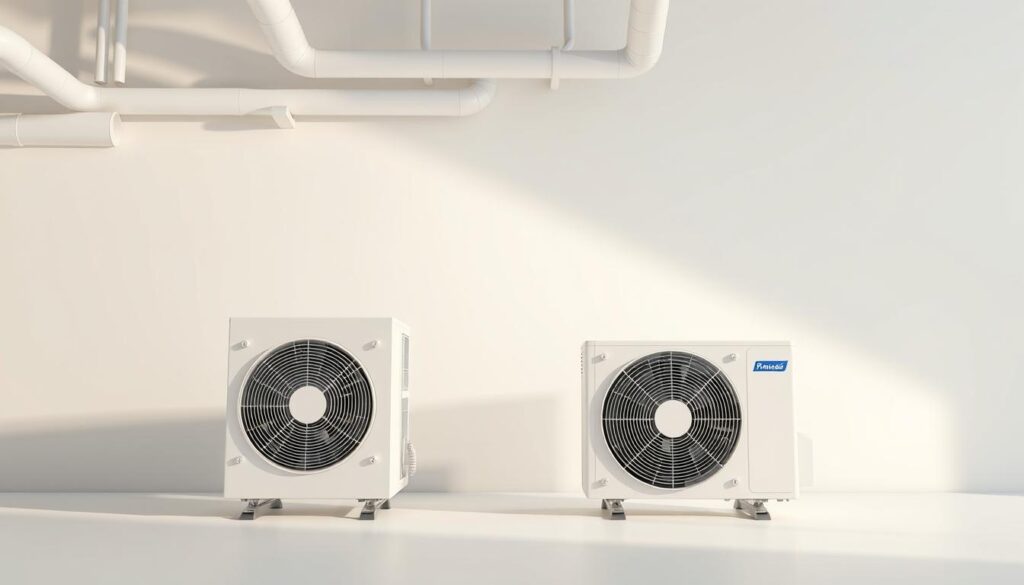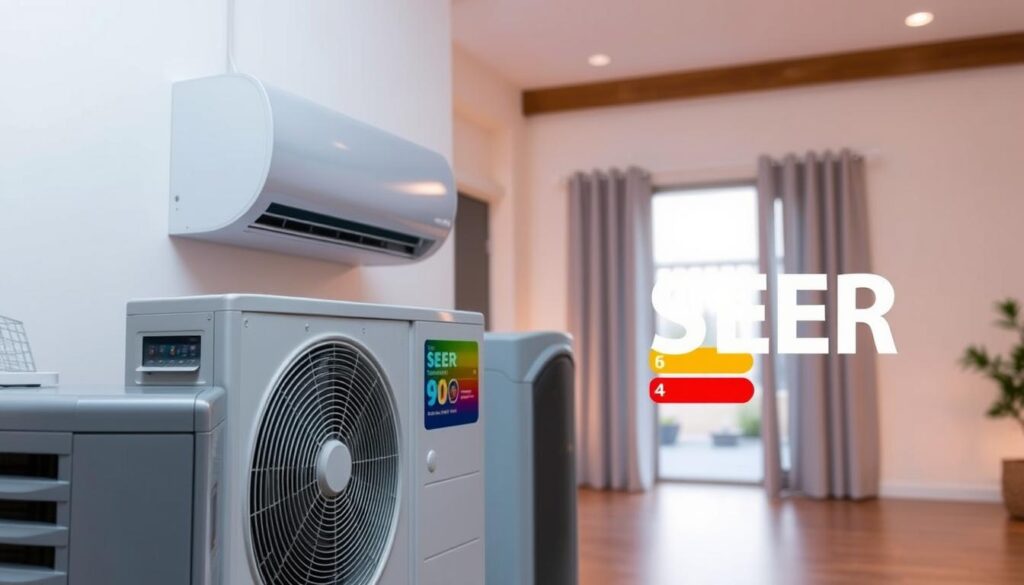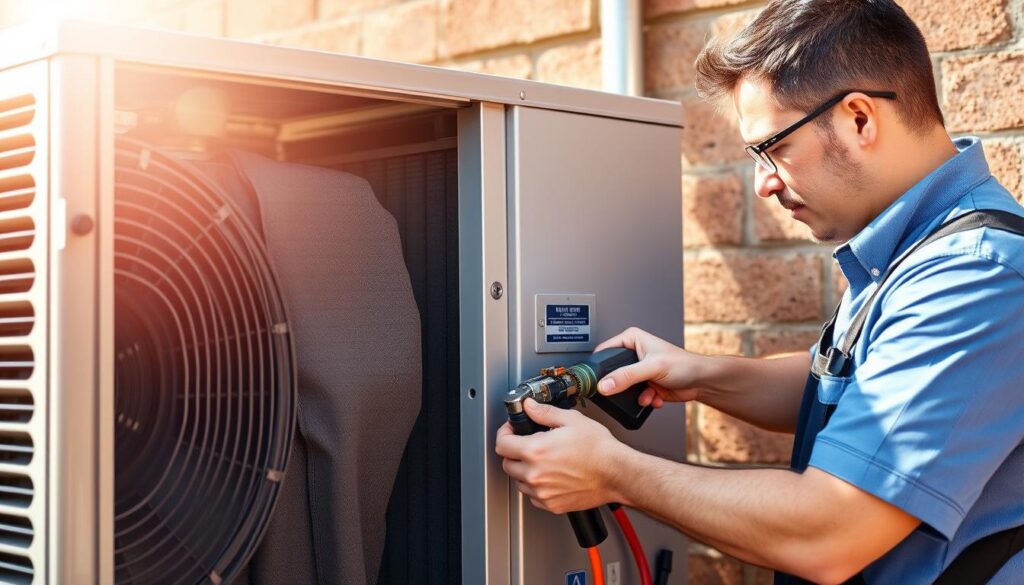Affiliate Disclosure
HVAC Guide Guys is a participant in the Amazon Services LLC Associates Program, an affiliate advertising program designed to provide a means for sites to earn advertising fees by advertising and linking to Amazon.
What is a Split HVAC System? Ever wondered how homes stay perfectly cool without big window units or messy ducts? Split HVAC systems might be the answer you’re looking for.

A split system is a modern way to keep your home comfortable. It’s different from old HVAC systems because it splits the job between inside and outside parts. These parts are connected by copper tubing, which helps the refrigerant move smoothly.
Exploring what a split HVAC system is? It’s a smart way to control the climate. These systems can cool your home in summer and warm it in winter. They’re great for both homes and businesses.
Split HVAC systems give you more control over your home’s temperature. They let you enjoy comfort exactly how you want it, without the limits of older systems.
Key Takeaways
- Split HVAC systems use separate indoor and outdoor units
- Provides flexible heating and cooling solutions
- More energy-efficient than traditional HVAC systems
- Allows zone-based temperature control
- Requires professional installation for optimal performance
Table of Contents
Understanding Split HVAC System Basics
Split HVAC systems are a smart way to heat and cool your home. They let you control the temperature easily and use less energy. Knowing how they work shows their clever design and great performance.
At the heart of a split HVAC system are two main parts: the indoor and outdoor units. Unlike old systems, these work together to make your home comfy.
Core Components and Their Functions
Looking at the key parts of a split HVAC system shows its benefits:
- Outdoor Unit: Houses the compressor and condenser
- Indoor Unit: Contains the evaporator coil and air handler
- Refrigerant Lines: Connect both units, facilitating heat transfer
- Thermostat: Provides precise temperature control
Indoor and Outdoor Unit Collaboration
The indoor and outdoor units work together. When you set the temperature, they start a heat exchange process. The outdoor unit compresses refrigerant, and the indoor unit absorbs or releases heat.
Refrigerant Line Dynamics
Refrigerant lines are key for communication between the units. These copper tubes carry refrigerant, helping to transfer heat and control temperature in your home.
Understanding these parts shows the advanced engineering of split HVAC systems. They offer tailored, energy-saving climate control.
Types of Split System Air Conditioners
When choosing a split system air conditioner, you’ll find many options. Each is designed for different cooling needs. Knowing the types can help you pick the right one for your home.
- Single-Zone Split Systems: Great for cooling single rooms or small areas
- Multi Zone Split AC System: Best for homes needing cooling in different zones
- Heat Pump Split Systems: They heat and cool your space
- Central Air Split Systems: Ideal for cooling your whole home
Ductless mini split vs central air is a big decision for homeowners. Ductless systems are flexible and control temperature by zone. Central air cools your home evenly, perfect for bigger spaces.
Different split systems work with various indoor units:
- Gas furnace combinations
- Fan coil units
- Air handlers
Your home’s layout, climate, and cooling needs will guide your choice. Talking to HVAC experts can help you find the perfect fit for your home.
Explore Our HVAC Shop
Looking for top-rated HVAC tools, parts, and accessories? Visit our shop and find the perfect solution for your needs.
Visit the ShopWhat is a Split HVAC System: Components and Operation
A split HVAC system is a cooling solution that separates into indoor and outdoor units. It works by having key parts in each area. This design makes it efficient and effective.
Modern split HVAC systems use a network of parts to control temperature. They offer a flexible cooling solution for different homes. This makes them powerful and adaptable.
Compressor and Condenser Unit
The outdoor unit has two main parts:
- Compressor: Pressurizes refrigerant and starts heat transfer
- Condenser: Releases heat from indoor spaces
The compressor changes refrigerant into a high-pressure, high-temperature gas. This is key for cooling.
Evaporator Coil and Air Handler
Inside, two parts work together for comfort:
- Evaporator Coil: Takes heat from indoor air
- Air Handler: Moves cooled air around your home
The evaporator coil cools air with refrigerant. The air handler spreads this cool air in your home.
Thermostat and Control Systems
Advanced controls manage temperature:
| Control Component | Primary Function |
|---|---|
| Digital Thermostat | Monitors and controls indoor temperature |
| Sensor Network | Provides temperature feedback |
| Smart Controls | Allows remote temperature changes |
These smart systems make your HVAC work efficiently. They keep your home comfortable while saving energy.
Split System Heat Pumps vs Traditional AC Units
Exploring split system heating and cooling options is key for homeowners. It’s important to know the difference between heat pump systems and traditional AC units. This knowledge helps in choosing the best climate control solution.
Heat pump systems stand out in the world of ductless mini split vs central air. They don’t just cool your space like traditional AC units. Instead, they provide both heating and cooling with great efficiency.
- Heat pump technology draws warmth from outside air
- Operates effectively in moderate temperature ranges
- Uses electricity to transfer heat instead of generating it
Choosing between a heat pump and a traditional AC unit depends on several factors:
- Climate considerations: Heat pump performance varies by region
- Energy efficiency: Heat pump systems typically consume less electricity
- Installation costs: Initial investment differs between systems
In moderate climates, heat pump systems can cut down on energy use. They keep your home at a comfortable temperature while using less electricity. This makes them a great choice for those looking to save money.
Heat pump technology represents a smart, versatile approach to home climate control.
Choosing the right split system heating and cooling solution is important. It depends on your specific needs, local climate, and energy efficiency goals.
Ducted vs Ductless Split Systems
Choosing a home cooling solution means picking between ducted and ductless mini split systems. Knowing the differences helps you pick the best cooling method for your home.
Traditional Ducted Systems
Ducted split systems use air channels to cool your home. They connect to a central unit, sending cool air through ducts in walls and ceilings.
- Suitable for entire home cooling
- Requires extensive ductwork installation
- Best for larger homes
Multi Zone Split AC System Options
Ductless mini splits cool individual rooms or zones. They let you set different temperatures in different areas, unlike central air.
| System Type | Cooling Flexibility | Installation Complexity |
|---|---|---|
| Ducted Split System | Whole-home cooling | High |
| Ductless Multi Zone Split AC | Room-specific cooling | Low |
Zoning Capabilities
The multi zone split ac system is great for zoning. You can cool different areas like bedrooms and living rooms separately. This creates personalized comfort zones without needing many units.
When deciding between ductless mini split and central air, think about your cooling needs, home layout, and budget. Each system has its own benefits that can greatly improve your home’s comfort and energy use.
Explore Our HVAC Shop
Looking for top-rated HVAC tools, parts, and accessories? Visit our shop and find the perfect solution for your needs.
Visit the ShopEnergy Efficiency and SEER Ratings

Homeowners should know how split HVAC systems save energy and money. SEER (Seasonal Energy Efficiency Ratio) ratings show how well a system works. They also tell you how much energy you can save.
SEER ratings go from the Department of Energy’s minimum to up to 24 SEER2. The higher the rating, the better the system is at saving energy. Energy Star® certification means the system is top-notch for cooling.
- Minimum DOE SEER rating: 13-14
- Mid-range efficient systems: 15-18 SEER
- High-efficiency models: 19-24 SEER2
“Choosing a high-efficiency split HVAC system can reduce your energy consumption by up to 40%” – Energy Efficiency Experts
Energy efficiency is key when looking at split HVAC systems. Modern systems with high SEER ratings offer big benefits:
- Lower monthly utility bills
- Less carbon footprint
- Better cooling
- Longer system life
| SEER Rating | Energy Efficiency Level | Estimated Annual Savings |
|---|---|---|
| 13-14 | Standard Efficiency | Base Cost |
| 15-18 | Good Efficiency | 10-20% Savings |
| 19-24 | High Efficiency | 25-40% Savings |
Choosing a high-efficiency split HVAC system with a great SEER rating saves money over time. It keeps your home comfortable too.
Installation Requirements and Considerations
Installing a split system heating and cooling solution needs careful planning and expert help. Your mini split installation requirements involve several key factors. These factors can affect how well it works and how efficient it is.
Before starting the installation, you must think about many things. These things affect how well it works and how much it costs.
Space Requirements for Installation
Successful split system installations need good planning of space. You’ll need to check:
- Enough space around outdoor units
- Enough wall space for indoor air handlers
- The right distance between indoor and outdoor parts
- If the mounting surfaces are strong enough
Professional Installation Process
Professional technicians are key in mini split installation. They will:
- Do a full site check
- Find the best place for units
- Make sure refrigerant lines are connected right
- Check if the electrical is compatible
- Test how well the system works
Location Planning Strategies
Good location planning affects your split system’s cost. Think about these important points:
- Avoid direct sunlight for outdoor units
- Keep air handlers clear of obstructions
- Choose spots with little electromagnetic interference
- Make sure there’s a way for condensation to drain
Understanding these installation tips can help your split HVAC system work better. It might also lower your long-term costs.
Advantages of Split HVAC Systems
Split HVAC systems are a smart choice for keeping your home cool. They offer more than just cooling, with great performance and flexibility for any space.
One big plus is how energy-efficient they are. They use less electricity than old systems, which means lower bills for you. Over time, this can save you a lot of money.
- Customizable zone cooling for individual room comfort
- Quiet operation with minimal noise disruption
- Compact design saving valuable living space
- Enhanced air quality through advanced filtration
With a split system, you can control the temperature in each room. This means you only cool the rooms you’re using. It’s a big win for saving energy.
“Split HVAC systems represent the future of home climate control, providing unparalleled comfort and efficiency.” – HVAC Engineering Quarterly
These systems are also great for homes with unique designs. They can fit into small spaces or complex layouts, making them perfect for your home.
- Easy maintenance with accessible components
- Long-term durability
- Potential increase in property value
Choosing a split HVAC system is a smart move. It brings comfort, efficiency, and long-term savings to your home.
Maintenance and Care Tips

It’s important to keep your split system heating and cooling in good shape. This helps save energy and avoids expensive fixes. Regular care can make your HVAC system last longer and work better all year.
Here are some key tips to keep your split HVAC system running efficiently:
- Clean or replace air filters every 1-3 months
- Clear debris from outdoor unit regularly
- Check refrigerant levels annually
- Inspect electrical connections
- Clean indoor and outdoor coils
Getting professional help is key to protecting your investment. Annual professional checks can spot problems early, saving you money. Experts can do detailed checks that homeowners can’t, keeping your system running smoothly.
Doing simple maintenance yourself can also cut costs. Keeping the outdoor unit area clean and changing filters often can boost your system’s performance. This also cuts down on energy use.
A well-maintained HVAC system can save up to 15% on energy costs and prevent unexpected breakdowns.
Signs you need a pro include:
- Unusual noises
- Inconsistent cooling or heating
- Increased energy bills
- Weak airflow
- Frequent cycling
By spending a little time and effort on regular maintenance, you’ll enjoy steady comfort. Plus, you’ll get the most out of your split HVAC system for many years.
Explore Our HVAC Shop
Looking for top-rated HVAC tools, parts, and accessories? Visit our shop and find the perfect solution for your needs.
Visit the ShopCost Analysis: Installation and Operation
It’s important for homeowners to understand the costs of split system heating and cooling. These systems come with various prices to fit different budgets. They also offer great energy efficiency.
Initial Investment Breakdown
The cost of split HVAC systems depends on several factors:
- System type (ducted or ductless)
- Home square footage
- Brand and model complexity
- Installation requirements
Homeowners usually spend between $3,000 and $15,000 for a split system. The long-term savings make the initial cost worth it.
Long-term Operating Costs
Split systems are more cost-effective over time. They use less energy than traditional systems, leading to lower bills.
- Average annual operating costs: $500-$1,500
- Potential energy savings: 20-30% compared to standard systems
- Reduced maintenance expenses
Energy Savings
Choosing a high-efficiency split HVAC system saves money. Modern units with advanced technologies can dramatically reduce energy consumption. This helps you save while keeping your home comfortable.
Homeowners might also get federal tax credits and local rebates. These can help lower the initial cost and make the system more valuable.
Split System vs Packaged Units Comparison
Choosing the right HVAC system is important. Knowing the difference between split systems and packaged units helps. Each has its own benefits for different homes.
Split systems have two parts: an indoor unit and an outdoor compressor. This setup is more flexible and often saves energy. On the other hand, packaged units have everything in one outdoor unit. They’re great for homes with little indoor space.
| Feature | Split System | Packaged Unit |
|---|---|---|
| Installation Complexity | More complex, requires indoor and outdoor components | Simpler, single unit installation |
| Energy Efficiency | Higher SEER ratings | Lower energy efficiency |
| Space Requirements | Flexible indoor/outdoor placement | Compact, exterior-only placement |
When deciding between ductless mini splits and central air, consider a few things:
- Home layout and available space
- Climate conditions in your region
- Budget for initial installation
- Long-term energy costs
Packaged units are best for small homes or places with little indoor space. Split systems are more versatile, great for bigger homes needing zoned cooling. Your home’s layout and local climate will decide the best HVAC system for you.
Conclusion
Learning about split HVAC systems can really change how comfortable and energy-efficient your home is. These systems let you control the temperature just right for your space. When choosing a split HVAC system, think about how well it works, the cost, and its long-term benefits.
Split HVAC systems do more than just cool your home. They come in different types, like ducted or ductless, fitting any home size. They also save energy, which can lower your bills and keep your home just right.
Getting a professional to install your system is key. A good HVAC tech will pick the best setup for your home. This ensures your system works well and lasts longer.
When picking your HVAC, talk to local experts. They can give advice based on your home, budget, and what you need for comfort. Making a smart choice means a happier, more efficient home for years.

